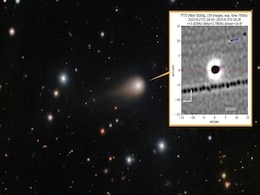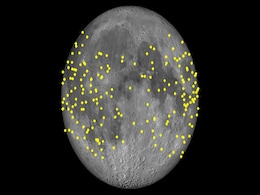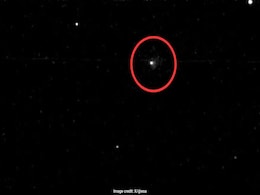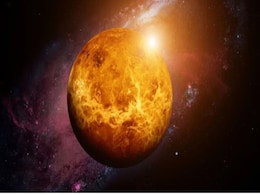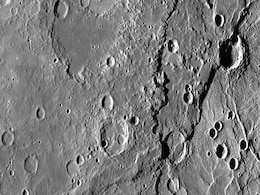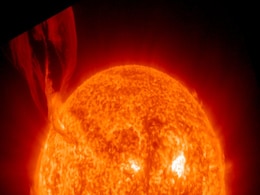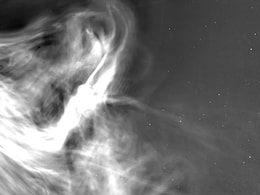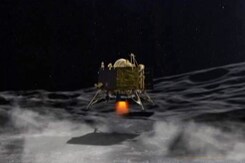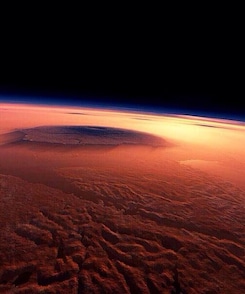Solar Surface
- All
- News
- Videos
- Web Stories
-

Massive Sunspot Complex on the Sun Raises Risk of Strong Solar Storms
- Tuesday December 9, 2025
A massive sunspot complex has appeared on the Sun, covering an area comparable to the legendary Carrington Event region. Known as AR 4294-96, the active cluster features highly tangled magnetic fields that could unleash powerful solar flares and geomagnetic storms, potentially disrupting satellites, power grids, and global communications if Earth-d...
-
 www.gadgets360.com
www.gadgets360.com
-

Icy Moons Might Have Oceans That Briefly Boil, Study Suggests
- Thursday December 4, 2025
A new study suggests that icy moons such as Mimas and Enceladus may host boiling subsurface oceans triggered by thinning ice shells and falling pressure. This low-temperature boiling could still support life beneath the surface. The research also explains geological features on larger icy moons and strengthens their potential as sites for finding e...
-
 www.gadgets360.com
www.gadgets360.com
-

Boiling Oceans May Hide Beneath Icy Moons, New Study Suggests
- Wednesday November 26, 2025
A new study suggests that icy moons such as Mimas and Enceladus may host boiling subsurface oceans triggered by thinning ice shells and falling pressure. This low-temperature boiling could still support life beneath the surface. The research also explains geological features on larger icy moons and strengthens their potential as sites for finding e...
-
 www.gadgets360.com
www.gadgets360.com
-

Scientist Claims Alien Probes May Be In Plain Sight, Observing Earth's Growing Intelligence
- Tuesday November 11, 2025
- Science |
Ellery suggested that building a nuclear reactor on the Moon could yield chemical signatures that could be explored in the future.
-
 www.ndtv.com
www.ndtv.com
-

Scientists Detect Hidden Magnetic Waves That Could Explain the Sun’s Mysterious Heat
- Sunday November 2, 2025
For the first time, scientists have directly observed twisting Alfvén waves in the Sun’s corona using the Inouye Solar Telescope. The discovery could explain why the Sun’s outer atmosphere is millions of degrees hotter than its surface, offering key insights into solar energy transfer and space weather prediction.
-
 www.gadgets360.com
www.gadgets360.com
-

New Images of Interstellar Object 3I/ATLAS Show a Giant Jet Shooting Toward the Sun
- Sunday October 26, 2025
New telescope images show interstellar comet 3I/ATLAS ejecting a giant jet of gas and dust toward the Sun. Scientists say the phenomenon confirms its natural cometary behaviour, offering clues about how such ancient interstellar visitors react to solar heat.
-
 www.gadgets360.com
www.gadgets360.com
-

NASA and ESA Trace Mysterious Lunar Flashes to Meteors and Gas Leaks
- Wednesday October 22, 2025
Transient Lunar Phenomena are mysterious bursts and glows observed on the Moon, lasting from milliseconds to hours. NASA and ESA research show that these events often result from meteoroid impacts, radon gas outgassing, and dust charged by solar wind, illuminating the Moon’s dynamic surface in surprising ways.
-
 www.gadgets360.com
www.gadgets360.com
-

MIT Detects Traces of a Lost ‘Proto Earth’ Deep Beneath Our Planet’s Surface
- Monday October 20, 2025
MIT researchers have discovered rare isotopic traces of a “proto Earth” that existed before the giant impact that shaped our modern planet. Found deep in ancient rocks, these potassium isotope signatures reveal remnants of Earth’s earliest material, offering fresh insight into the planet’s formation and the solar system’s earliest history...
-
 www.gadgets360.com
www.gadgets360.com
-

Scientists May Finally Explain Mysterious Crown-Like Features on Venus
- Tuesday September 30, 2025
Venus’ distinctive crown-like coronae may be explained by heat trapped beneath a rigid mantle layer, according to recent studies. This discovery provides key insights into the planet’s geological activity and helps researchers compare Venus’ surface evolution to that of other planets in our solar system
-
 www.gadgets360.com
www.gadgets360.com
-

Mercury Has Shrunk by Several Kilometers Over Billions of Years, Scientists Report
- Tuesday August 19, 2025
Mercury’s surface reveals it has been shrinking for billions of years due to cooling and faulting. A new study estimates the planet’s radius has contracted by 2.7–5.6 kilometers, offering the most precise figures yet. The findings sharpen understanding of Mercury’s thermal evolution and could help scientists apply the same techniques to tec...
-
 www.gadgets360.com
www.gadgets360.com
-

Colossal Solar Filament Eruption Sculpts 250,000-Mile 'Canyon of Fire' on the Sun’s Surface
- Friday July 18, 2025
A massive July 15 filament eruption from the sun’s limb carved a 250,000‑mile‑long plasma canyon captured by NASA’s SDO. The spectacular rift, formed as magnetic fields realigned, featured 12,400‑mile‑high plasma walls. Although the eruption launched a coronal mass ejection into space, SOHO and GOES‑19 imagery confirm it’s heading a...
-
 www.gadgets360.com
www.gadgets360.com
-

NASA’s Parker Probe Sends Closest-Ever Images from Inside the Sun’s Corona
- Thursday July 17, 2025
NASA’s Parker Solar Probe has achieved a solar milestone by capturing the closest-ever images of the Sun, taken just 3.8 million miles from its surface in December 2024. These WISPR images reveal unprecedented details of the corona, solar wind, and CME collisions. Scientists say this breakthrough will improve our ability to forecast space weather...
-
 www.gadgets360.com
www.gadgets360.com
-

Massive Sunspot Complex on the Sun Raises Risk of Strong Solar Storms
- Tuesday December 9, 2025
A massive sunspot complex has appeared on the Sun, covering an area comparable to the legendary Carrington Event region. Known as AR 4294-96, the active cluster features highly tangled magnetic fields that could unleash powerful solar flares and geomagnetic storms, potentially disrupting satellites, power grids, and global communications if Earth-d...
-
 www.gadgets360.com
www.gadgets360.com
-

Icy Moons Might Have Oceans That Briefly Boil, Study Suggests
- Thursday December 4, 2025
A new study suggests that icy moons such as Mimas and Enceladus may host boiling subsurface oceans triggered by thinning ice shells and falling pressure. This low-temperature boiling could still support life beneath the surface. The research also explains geological features on larger icy moons and strengthens their potential as sites for finding e...
-
 www.gadgets360.com
www.gadgets360.com
-

Boiling Oceans May Hide Beneath Icy Moons, New Study Suggests
- Wednesday November 26, 2025
A new study suggests that icy moons such as Mimas and Enceladus may host boiling subsurface oceans triggered by thinning ice shells and falling pressure. This low-temperature boiling could still support life beneath the surface. The research also explains geological features on larger icy moons and strengthens their potential as sites for finding e...
-
 www.gadgets360.com
www.gadgets360.com
-

Scientist Claims Alien Probes May Be In Plain Sight, Observing Earth's Growing Intelligence
- Tuesday November 11, 2025
- Science |
Ellery suggested that building a nuclear reactor on the Moon could yield chemical signatures that could be explored in the future.
-
 www.ndtv.com
www.ndtv.com
-

Scientists Detect Hidden Magnetic Waves That Could Explain the Sun’s Mysterious Heat
- Sunday November 2, 2025
For the first time, scientists have directly observed twisting Alfvén waves in the Sun’s corona using the Inouye Solar Telescope. The discovery could explain why the Sun’s outer atmosphere is millions of degrees hotter than its surface, offering key insights into solar energy transfer and space weather prediction.
-
 www.gadgets360.com
www.gadgets360.com
-

New Images of Interstellar Object 3I/ATLAS Show a Giant Jet Shooting Toward the Sun
- Sunday October 26, 2025
New telescope images show interstellar comet 3I/ATLAS ejecting a giant jet of gas and dust toward the Sun. Scientists say the phenomenon confirms its natural cometary behaviour, offering clues about how such ancient interstellar visitors react to solar heat.
-
 www.gadgets360.com
www.gadgets360.com
-

NASA and ESA Trace Mysterious Lunar Flashes to Meteors and Gas Leaks
- Wednesday October 22, 2025
Transient Lunar Phenomena are mysterious bursts and glows observed on the Moon, lasting from milliseconds to hours. NASA and ESA research show that these events often result from meteoroid impacts, radon gas outgassing, and dust charged by solar wind, illuminating the Moon’s dynamic surface in surprising ways.
-
 www.gadgets360.com
www.gadgets360.com
-

MIT Detects Traces of a Lost ‘Proto Earth’ Deep Beneath Our Planet’s Surface
- Monday October 20, 2025
MIT researchers have discovered rare isotopic traces of a “proto Earth” that existed before the giant impact that shaped our modern planet. Found deep in ancient rocks, these potassium isotope signatures reveal remnants of Earth’s earliest material, offering fresh insight into the planet’s formation and the solar system’s earliest history...
-
 www.gadgets360.com
www.gadgets360.com
-

Scientists May Finally Explain Mysterious Crown-Like Features on Venus
- Tuesday September 30, 2025
Venus’ distinctive crown-like coronae may be explained by heat trapped beneath a rigid mantle layer, according to recent studies. This discovery provides key insights into the planet’s geological activity and helps researchers compare Venus’ surface evolution to that of other planets in our solar system
-
 www.gadgets360.com
www.gadgets360.com
-

Mercury Has Shrunk by Several Kilometers Over Billions of Years, Scientists Report
- Tuesday August 19, 2025
Mercury’s surface reveals it has been shrinking for billions of years due to cooling and faulting. A new study estimates the planet’s radius has contracted by 2.7–5.6 kilometers, offering the most precise figures yet. The findings sharpen understanding of Mercury’s thermal evolution and could help scientists apply the same techniques to tec...
-
 www.gadgets360.com
www.gadgets360.com
-

Colossal Solar Filament Eruption Sculpts 250,000-Mile 'Canyon of Fire' on the Sun’s Surface
- Friday July 18, 2025
A massive July 15 filament eruption from the sun’s limb carved a 250,000‑mile‑long plasma canyon captured by NASA’s SDO. The spectacular rift, formed as magnetic fields realigned, featured 12,400‑mile‑high plasma walls. Although the eruption launched a coronal mass ejection into space, SOHO and GOES‑19 imagery confirm it’s heading a...
-
 www.gadgets360.com
www.gadgets360.com
-

NASA’s Parker Probe Sends Closest-Ever Images from Inside the Sun’s Corona
- Thursday July 17, 2025
NASA’s Parker Solar Probe has achieved a solar milestone by capturing the closest-ever images of the Sun, taken just 3.8 million miles from its surface in December 2024. These WISPR images reveal unprecedented details of the corona, solar wind, and CME collisions. Scientists say this breakthrough will improve our ability to forecast space weather...
-
 www.gadgets360.com
www.gadgets360.com








